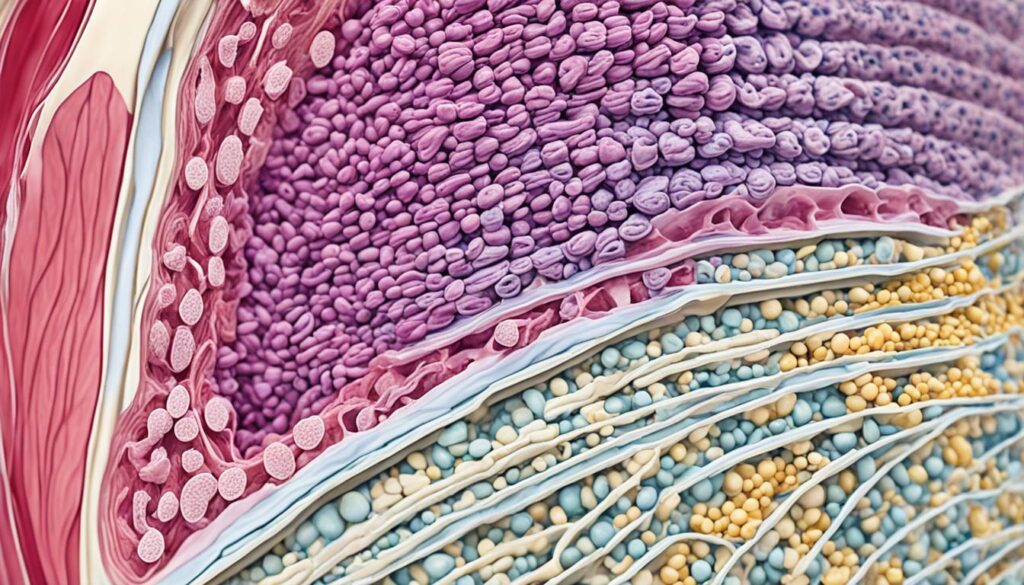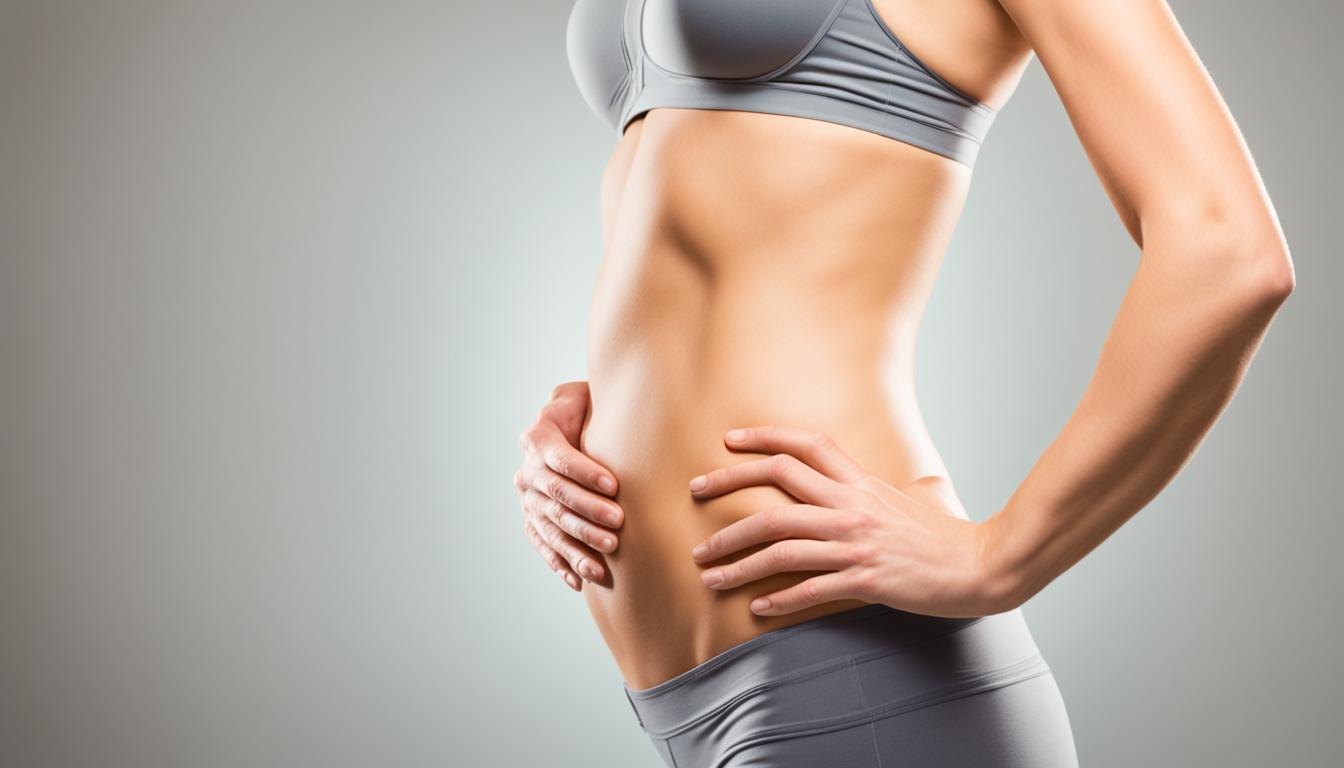Why does my lower stomach stick out female?
Have you ever wondered why your lower stomach seems to stick out, even when you’re doing everything right? Maintaining a healthy lifestyle is important, but sometimes stubborn belly fat in the lower abdomen can be a challenge to tackle. In this article, we’ll explore the various factors that contribute to lower stomach protrusion in women and provide effective strategies for managing it.
Whether you’re dealing with hormonal changes, muscle imbalances, or the aftermath of pregnancy, we’ll delve into the root causes of this common concern. From there, we’ll discuss exercises, dietary adjustments, and lifestyle modifications that can help you achieve a flatter and more confident lower stomach.
So, let’s dig into the reasons behind that stubborn lower belly pooch and discover how you can regain control over your abdominal appearance.
Key Takeaways:
- Hormonal changes, muscle imbalances, pregnancy, genetics, bloating, and stress can contribute to lower stomach protrusion in women.
- Improving core stability, targeting the transverse abdominus, and addressing muscle imbalances can help reduce the appearance of a protruding lower belly.
- Hormonal factors, such as changes in estrogen and testosterone levels, can affect lower belly fat accumulation in females.
- Pregnancy and childbirth can stretch the lower abdominal muscles, leading to diastasis recti and a protruding lower belly.
- Genetic factors can influence a person’s predisposition to lower stomach protrusion, but lifestyle modifications can still make a difference.
The Impact of Core Stability on Lower Stomach Appearance
Poor core stability can have a significant impact on the appearance of your lower stomach. When your core muscles are weak or imbalanced, it can lead to a protruding abdomen that is commonly referred to as a “belly pooch” or “lower belly fat.”
One of the key muscles that contribute to core stability is the transverse abdominus. This deep abdominal muscle plays a crucial role in stabilizing the spine and maintaining good posture. However, poor core stability often results in a weakened transverse abdominus, making it less effective in supporting the midsection.
In addition, another muscle group that can contribute to a bulging lower stomach is the external oblique muscles. These muscles, located on the sides of the abdomen, can become overactive and dominant in individuals with poor core stability. When these muscles are overactive, they can pull the abdomen forward, leading to a protrusion in the lower stomach area.
These muscle imbalances are commonly observed in women who have experienced pregnancy, as the abdominal muscles stretch during this time. However, it is important to note that poor core stability can also affect women and men who have not been pregnant.
To address the impact of core stability on lower stomach appearance, it is crucial to strengthen the transverse abdominus and rebalance the external oblique muscles. By doing so, you can reduce the protrusion in the lower stomach and achieve a flatter and more toned abdomen.
Here are some exercises that can help improve core stability and target the specific muscles involved:
- Planks: Planks are an excellent exercise for strengthening the transverse abdominus and the entire core. Start by holding a plank position for 30 seconds and gradually increase the duration as you build strength.
- Dead Bug: Lie on your back with your arms and legs in the air. Slowly lower opposite arm and leg towards the ground while maintaining a strong core. Repeat on the other side.
- Side Planks: Side planks target the oblique muscles. Begin by lying on your side and raising your body off the ground, supported by one forearm and the side of your foot. Hold for 30 seconds on each side.
- Bird Dog: Position yourself on all fours, with your hands directly under your shoulders and your knees under your hips. Extend one arm and the opposite leg at the same time while engaging your core. Repeat on the other side.
By incorporating these exercises into your fitness routine and focusing on core stability, you can start to see improvements in the appearance of your lower stomach. Along with exercise, maintaining a balanced diet and overall healthy lifestyle will also contribute to achieving a flatter and more toned abdomen.
| Core Exercises for Improving Core Stability | Instructions |
|---|---|
| Planks | Start in a push-up position with your elbows bent and forearms on the ground. Engage your core and hold the position for as long as possible, maintaining a straight line from head to toe. |
| Dead Bug | Lie on your back with your arms and legs in the air. Slowly lower opposite arm and leg towards the ground while maintaining a strong core. Repeat on the other side. |
| Side Planks | Start by lying on your side and raising your body off the ground, supported by one forearm and the side of your foot. Hold for 30 seconds on each side, focusing on engaging your oblique muscles. |
| Bird Dog | Position yourself on all fours, with your hands directly under your shoulders and your knees under your hips. Extend one arm and the opposite leg at the same time while engaging your core. Repeat on the other side. |
Hormonal Factors and Lower Belly Fat in Females
Hormonal changes are a key contributing factor to the accumulation of lower belly fat in females. These changes can be influenced by various factors such as menopause, testosterone levels, and stress-induced belly fat.
Changes in Estrogen Levels
During menopause, there is a significant decrease in estrogen levels. Estrogen plays a crucial role in regulating fat distribution in the body. As estrogen levels decline, there is a tendency for fat to be stored in the abdominal area, leading to lower belly fat accumulation in females.
Testosterone and Muscle Mass
Testosterone, although typically considered a male hormone, also plays a role in females’ body composition. Adequate levels of testosterone are essential for maintaining muscle mass and a healthy metabolism. However, the decline in testosterone levels during menopause can result in a loss of muscle mass, leading to a slower metabolism and making it harder to process carbohydrates.
Cortisol and Stress-Induced Belly Fat
Stress-induced belly fat is closely linked to cortisol production. When stress levels are high, the body releases cortisol, a hormone that promotes the accumulation of fat, especially in the abdominal area. Chronic stress and elevated cortisol levels can contribute to lower stomach protrusion in women.
To manage hormonal belly fat in females, it is important to adopt a holistic approach that addresses hormonal imbalances, manages stress levels, and promotes overall well-being. In the next section, we will explore the impact of pregnancy on lower stomach appearance and provide strategies for managing it.
The Impact of Pregnancy on Lower Stomach Appearance
Pregnancy and childbirth can bring about significant changes in the appearance of the lower stomach. The stretching of the abdominal muscles during pregnancy can result in a condition known as diastasis recti, which involves the separation of the abdominal wall muscles. This can contribute to a protruding lower belly.
If you are concerned about the appearance of your lower stomach after pregnancy, specific exercises can help address diastasis recti and strengthen the abdominal muscles. Pelvic floor exercises, also known as Kegel exercises, can help strengthen the deep core muscles and provide support for the abdomen. Yoga can also be beneficial, as it focuses on both strength and flexibility, aiding in the toning of the abdominal area.

Tips for Post-Pregnancy Exercises
When engaging in post-pregnancy exercises, it’s important to start slowly and listen to your body. Here are some tips to keep in mind:
- Consult with your healthcare provider before starting any exercise program.
- Focus on exercises that target the abdominal muscles, such as planks and modified crunches.
- Incorporate exercises that strengthen the pelvic floor, such as Kegel exercises.
- Practice proper posture during exercises to engage the core muscles effectively.
- Gradually increase the intensity and duration of your workouts as your strength improves.
- Consider working with a certified postnatal fitness specialist for personalized guidance.
Remember, each person’s body is unique, and it’s essential to honor your own journey post-pregnancy. With a combination of targeted exercises and patience, you can gradually strengthen your abdominal muscles and improve the appearance of your lower stomach.
The Role of Genetics in Lower Stomach Protrusion
Genetic factors play a significant role in determining an individual’s predisposition to lower stomach protrusion. If you have a family history of belly fat or a specific body shape, such as a rounder belly, you may be more likely to develop a similar physical characteristic.
While genetics are something you cannot change, it is important to note that lifestyle factors can still help manage lower stomach protrusion. Adopting a healthy diet and engaging in regular exercise can make a difference in your overall body composition, even if you have a genetic predisposition to belly fat.
Furthermore, understanding your body and making conscious decisions to support your health can lead to positive changes. By incorporating targeted exercises that focus on toning the lower stomach, you can strengthen the underlying muscles and reduce excess fat in that area.
“Your genetics may influence your lower stomach protrusion, but by modifying your lifestyle, you can still manage and improve the appearance of a protruding lower belly.”
By taking ownership of your health and making informed choices, you can effectively manage lower stomach protrusion and achieve a flatter abdomen. Remember that small changes in your diet, exercise routine, and self-care habits can add up to significant improvements over time.
Lifestyle Factors That Can Help Manage Lower Stomach Protrusion
| Lifestyle Factors | Actions |
|---|---|
| Diet | Choose a balanced diet rich in fruits, vegetables, lean proteins, and healthy fats. Reduce your intake of processed foods, sugary drinks, and refined carbohydrates. |
| Exercise | Incorporate a combination of cardiovascular exercises, strength training, and core exercises into your fitness routine. Focus on exercises that target the lower stomach area. |
| Stress Management | Practice stress reduction techniques, such as mindfulness, meditation, or engaging in activities you enjoy. High stress levels can contribute to belly fat accumulation. |
| Posture | Pay attention to your posture and practice good alignment. Engage your core muscles to support proper posture and reduce the appearance of a protruding lower belly. |
By addressing these lifestyle factors, you can take control of your lower stomach protrusion and work towards achieving a flatter and more confident abdomen.

Bloating and its Impact on Lower Stomach Appearance
Bloating in the lower abdomen can cause temporary protrusion, making your stomach appear larger than usual. This uncomfortable condition is often the result of various factors, such as food intolerances, gas or fluid retention, and constipation. By understanding the causes of bloating and making dietary adjustments, you can alleviate bloating and reduce lower stomach protrusion.
The Causes of Bloating in the Lower Abdomen
Bloating occurs when your stomach feels full, tight, and swollen due to excess gas or fluid retention. Several factors contribute to bloating in the lower abdomen:
- Food intolerances: Certain foods can trigger bloating in individuals who are intolerant or sensitive to them. Common culprits include lactose, gluten, and certain vegetables like broccoli and cabbage.
- Gas retention: Swallowing air while eating or drinking, as well as the fermentation of undigested food in the colon, can lead to the accumulation of gas in the lower abdomen.
- Constipation: When stool builds up in the colon, it can cause bloating and discomfort in the lower abdomen.
Identifying the specific cause of your bloating can help guide your dietary adjustments and alleviate the associated lower stomach protrusion.
Dietary Adjustments for Alleviating Bloating
Fortunately, making changes to your diet can help reduce bloating and minimize the appearance of a protruding lower stomach. Consider implementing the following adjustments:
- Avoid gas-inducing foods: Steer clear of foods that are known to cause gas, such as beans, carbonated beverages, onions, and certain fruits.
- Eat smaller, more frequent meals: Instead of consuming large meals, try eating smaller, more frequent meals throughout the day to aid digestion and prevent bloating.
- Incorporate fiber-rich foods: Opt for fiber-rich foods like whole grains, fruits, and vegetables, as they can promote regular bowel movements and reduce constipation.
- Stay hydrated: Drinking an adequate amount of water can prevent dehydration, help regulate digestion, and minimize bloating.
By making these dietary adjustments, you can address the underlying causes of bloating, alleviate discomfort, and reduce the appearance of a protruding lower stomach.

Managing Lower Stomach Protrusion through a Healthy Lifestyle
To reduce lower stomach protrusion, a combination of targeted exercises and a balanced diet is crucial. By incorporating exercises that specifically target the lower stomach area, such as cardio, strength training, and core exercises, you can tone the muscles and reduce excess fat.
To further support your progress, adopting a nutrition plan that includes healthy fats, lean proteins, and fiber-rich fruits and vegetables is essential. This will not only aid in overall weight loss but also target lower belly fat specifically.
Exercises for Lower Stomach Fat
The following exercises can help you specifically target and reduce lower stomach fat:
- Plank: This exercise engages your entire core, including the lower abdominal muscles. Start by assuming a push-up position, with your forearms on the ground and your body in a straight line. Hold this position for as long as you can, gradually increasing the duration over time.
- Leg Raises: Lie flat on your back with your legs extended. Slowly lift your legs towards the ceiling, keeping them straight. Lower them back down to the starting position with control. Repeat for a recommended number of repetitions.
- Bicycle Crunches: Lie on your back with your hands behind your head and your knees bent. Lift your shoulder blades off the ground and twist your torso, bringing your left elbow towards your right knee while extending your left leg. Repeat on the other side.
Tips to Flatten Lower Stomach
- Maintain a Consistent Workout Routine: Regularly engaging in physical activity will help burn calories and reduce overall body fat, including in the lower stomach area.
- Stay Hydrated: Drinking an adequate amount of water throughout the day helps maintain proper digestion and minimizes bloating, promoting a flatter stomach.
- Avoid Sugary Drinks: Sugary beverages, such as soda and fruit juices, can contribute to weight gain and further add to lower stomach protrusion. Opt for water or unsweetened beverages instead.
- Get Sufficient Sleep: Prioritizing quality sleep is important for maintaining a healthy weight and hormonal balance, both of which can affect the appearance of the lower stomach.
By incorporating these exercises and implementing these tips, you can effectively manage lower stomach protrusion and achieve a flatter abdomen.
Diet Recommendations for Lower Stomach Fat
Your diet plays a significant role in reducing lower stomach fat. Consider the following recommendations:
| Food Group | Recommendations |
|---|---|
| Healthy Fats | Incorporate sources of healthy fats into your diet, such as avocados, nuts, and olive oil. These provide essential nutrients and promote satiety. |
| Lean Proteins | Include lean protein sources, such as chicken breast, fish, tofu, or legumes, in your meals. Protein helps build and repair muscles while keeping you feeling full. |
| Fiber-Rich Fruits and Vegetables | Eat a variety of fruits and vegetables, as they are high in fiber and low in calories. This combination promotes digestion, satiety, and overall gut health. |
A well-rounded diet that includes these recommendations, combined with regular exercise, will aid in reducing lower stomach fat and achieving a flatter appearance.
How Stress and Sleep Patterns Affect Lower Stomach Protrusion
Chronic stress and disrupted sleep patterns can have a significant impact on the appearance of lower stomach protrusion. The stress hormone cortisol plays a crucial role in the accumulation of abdominal fat, including stress-induced belly fat. When you experience chronic stress, cortisol levels remain elevated, leading to increased fat storage in the abdominal region.
Sleep deprivation can also contribute to lower stomach protrusion. When you don’t get enough quality sleep, it disrupts the regulation of hormones, including those involved in appetite control and metabolism. This can result in weight gain and potential changes in body composition, primarily favoring fat storage, especially in the abdominal area.
To reduce lower stomach protrusion, focus on managing stress levels and prioritizing quality sleep. Incorporate stress reduction techniques, such as meditation, deep breathing exercises, or engaging in activities that you find relaxing. Additionally, establish and maintain a consistent sleep schedule, aiming for 7-9 hours of uninterrupted sleep each night.
By proactively addressing stress and improving sleep patterns, you can help regulate cortisol levels, mitigate stress-induced belly fat, and promote a healthier body composition. The following table summarizes the key impacts of stress and sleep patterns on lower stomach protrusion:
| Impact | Description |
|---|---|
| Increased cortisol production | Elevated stress levels lead to higher cortisol production, resulting in the accumulation of belly fat. |
| Disrupted hormone regulation | Sleep deprivation disrupts the balance of hormones involved in appetite control and metabolism, contributing to weight gain and abdominal fat storage. |
| Changes in body composition | Inadequate sleep can favor fat storage in the abdominal area and promote an unfavorable body composition. |
By understanding the impact of stress and sleep patterns on lower stomach protrusion, you can take proactive steps to manage these factors and achieve a flatter abdomen.
Key Takeaways:
- Chronic stress can lead to stress-induced belly fat due to increased cortisol production.
- Sleep deprivation disrupts hormone regulation, promoting weight gain and abdominal fat storage.
- Manage stress levels through relaxation techniques and prioritize quality sleep to reduce lower stomach protrusion.
Addressing Lower Stomach Protrusion with Lifestyle Modifications
Lifestyle modifications can play a significant role in addressing lower stomach protrusion. By making targeted changes to your daily habits, you can effectively reduce the appearance of a protruding lower belly. Here are some strategies to consider:
Improving Posture and Core Strength
Corrective posture and core strengthening exercises can help alleviate lower stomach protrusion. By focusing on strengthening your core muscles and maintaining proper alignment, you can promote better posture and reduce the prominence of your lower belly. Engaging in exercises such as planks, bridges, and pelvic tilts can help improve muscle tone and support a flatter stomach.
Targeted Exercises for Diastasis Recti
Diastasis recti is a common condition that can contribute to lower stomach protrusion, especially in women after pregnancy. Specific exercises aimed at restoring abdominal muscle function can help minimize the separation of the abdominal wall muscles. Incorporating exercises like the standing side crunch, heel slides, and leg lifts can assist in strengthening the core muscles and improving the appearance of the lower stomach.
Implementing Stress Reduction Techniques
Stress can have a significant impact on lower stomach protrusion by increasing cortisol levels and promoting the accumulation of belly fat. Integrating stress reduction techniques into your routine, such as exercise, meditation, and deep breathing exercises, can help manage stress levels and mitigate its effects on your abdominal area. Prioritizing self-care and adopting stress reduction practices can contribute to a flatter stomach.
Remember, addressing lower stomach protrusion requires a holistic approach. Combine these lifestyle modifications with a balanced diet, regular exercise, and mindful habits to achieve the best results. By making positive changes to your daily routines, you can take control of your lower stomach appearance and improve your overall well-being.
Conclusion
Managing lower stomach protrusion requires a holistic approach that addresses the various contributing factors. By implementing lifestyle changes, you can achieve a flatter appearance and improved well-being.
Start by incorporating targeted exercises into your fitness routine to address muscle imbalances and strengthen your core. This includes exercises that specifically target the lower stomach, such as cardio, strength training, and core exercises.
In addition to exercise, adopting a balanced diet is crucial for managing lower stomach protrusion. Focus on consuming nutrient-dense foods, including lean proteins, healthy fats, and fiber-rich fruits and vegetables, while avoiding processed foods and excessive calorie intake.
It’s important to also prioritize stress management techniques and ensure quality sleep. Chronic stress and disrupted sleep patterns can contribute to lower stomach protrusion, so incorporating stress reduction techniques and establishing a consistent sleep routine can make a noticeable difference.
Incorporating these lifestyle modifications will help you effectively manage lower stomach protrusion, leading to a flatter appearance and increased confidence in your overall physical well-being.







